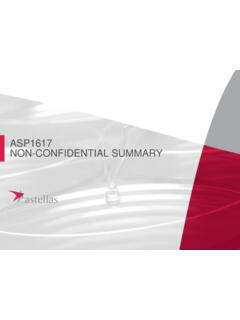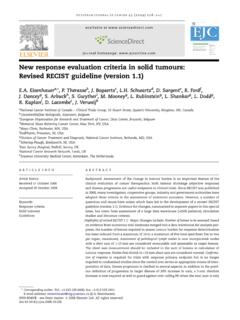Transcription of GAINING THE ADVANTAGE - Lockheed Martin Space
1 GAINING THE ADVANTAGEA pplying Cyber Kill Chain Methodology to Network DefenseTHE MODERN DAY ATTACKERC yberattacks aren t new, but the stakes at every level are higher than ever. Adversaries are more sophisticated, well-resourced, trained, and adept at launching skillfully planned intrusion campaigns called Advanced Persistent Threats (APT). Our nation s security and prosperity depend on critical infrastructure. Protecting these assets requires a clear understanding of our adversaries, their motivations and strategies. Adversaries are intent on the compromise and extraction of data for economic, political and national security advancement. Even worse, adversaries have demonstrated their willingness to conduct destructive attacks. Their tools and techniques have the ability to defeat most common computer network defense Lockheed Martin CYBER KILL CHAIN The Cyber Kill Chain framework is part of the Intelligence Driven Defense model for the identification and prevention of cyber intrusions activity.
2 The model identifies what the adversaries must complete in order to achieve their adversaries at any stage breaks the chain of attack! Adversaries must completely progress through all phases for success; this puts the odds in our favor as we only need to block them at any given one for success. Every intrusion is a chance to understand more about our adversaries and use their persistence to our ADVANTAGE . The kill chain model is designed in seven steps: fDefender s goal: understand the aggressor s actions fUnderstanding is Intelligence fIntruder succeeds if, and only if, they can proceed through steps 1-6 and reach the final stage of the Cyber Kill Chain .1234567 RECONNAISSANCE Identify the TargetsADVERSARYThe adversaries are in the planning phase of their operation. They conduct research to understand which targets will enable them to meet their objectives. fHarvest email addresses fIdentify employees on social media networks fCollect press releases, contract awards, conference attendee lists fDiscover internet-facing serversDEFENDERD etecting reconnaissance as it happens can be very difficult, but when defenders discover recon even well after the fact it can reveal the intent of the adversaries.
3 FCollect website visitor logs for alerting and historical searching. fCollaborate with web administrators to utilize their existing browser analytics. fBuild detections for browsing behaviors unique to reconnaissance. fPrioritize defenses around particular technologies or people based on recon Prepare the OperationADVERSARYThe adversaries are in the preparation and staging phase of their operation. Malware generation is likely not done by hand they use automated tools. A weaponizer couples malware and exploit into a deliverable payload. fObtain a weaponizer, either in-house or obtain through public or private channels fFor file-based exploits, select decoy document to present to the victim. fSelect backdoor implant and appropriate command and control infrastructure for operation fDesignate a specific mission id and embed in the malware fCompile the backdoor and weaponize the payloadDEFENDERThis is an essential phase for defenders to understand. Though they cannot detect weaponization as it happens, they can infer by analyzing malware artifacts.
4 Detections against weaponizer artifacts are often the most durable & resilient defenses. fConduct full malware analysis not just what payload it drops, but how it was made. fBuild detections for weaponizers find new campaigns and new payloads only because they re-used a weaponizer toolkit. fAnalyze timeline of when malware was created relative to when it was used. Old malware is malware off the shelf but new malware might mean active, tailored operations. fCollect files and metadata for future analysis. fDetermine which weaponizer artifacts are common to which APT campaigns. Are they widely shared or closely held?2 DELIVERY Launch the OperationADVERSARYThe adversaries convey the malware to the target. They have launched their operation. fAdversary controlled delivery: fDirect against web servers fAdversary released delivery: fMalicious email fMalware on USB stick fSocial media interactions f Watering hole compromised websitesDEFENDERThis is the first and most important opportunity for defenders to block the operation.
5 A key measure of effectiveness is the fraction of intrusion attempts that are blocked at delivery stage. fAnalyze delivery medium understand upstream infrastructure. fUnderstand targeted servers and people, their roles and responsibilities, what information is available. fInfer intent of adversary based on targeting. fLeverage weaponizer artifacts to detect new malicious payloads at the point of Delivery. fAnalyze time of day of when operation began. fCollect email and web logs for forensic reconstruction. Even if an intrusion is detected late, defenders must be able to determine when and how delivery Gain Access to VictimADVERSARYThe adversaries must exploit a vulnerability to gain access. The phrase zero day refers to the exploit code used in just this step. fSoftware, hardware, or human vulnerability fAcquire or develop zero day exploit fAdversary triggered exploits for server-based vulnerabilities fVictim triggered exploits fOpening attachment of malicious email fClicking malicious linkDEFENDERHere traditional hardening measures add resiliency, but custom capabilities are necessary to stop zero-day exploits at this stage.
6 FUser awareness training and email testing for employees. fSecure coding training for web developers. fRegular vulnerability scanning and penetration testing. fEndpoint hardening measures: fRestrict admin privileges fUse Microsoft EMET fCustom endpoint rules to block shellcode execution fEndpoint process auditing to forensically determine origin of Establish Beachhead at the VictimADVERSARYT ypically, the adversaries install a persistent backdoor or implant in the victim environment to maintain access for an extended period of time. fInstall webshell on web server fInstall backdoor/implant on client victim fCreate point of persistence by adding services, AutoRun keys, etc. fSome adversaries time stomp the file to make malware appear it is part of the standard operating system instrumentation to detect and log installation activity. Analyze installation phase during malware analysis to create new endpoint mitigations. fHIPS to alert or block on common installation paths, RECYCLER.
7 FUnderstand if malware requires administrator privileges or only user. fEndpoint process auditing to discover abnormal file creations. fExtract certificates of any signed executables. fUnderstand compile time of malware to determine if it is old or & CONTROL (C2) Remotely Control the ImplantsADVERSARYM alware opens a command channel to enable the adversary to remotely manipulate the victim. fOpen two way communications channel to C2 infrastructure fMost common C2 channels are over web, DNS, and email protocols fC2 infrastructure may be adversary owned or another victim network itselfDEFENDERThe defender s last best chance to block the operation: by blocking the C2 channel. If adversaries can t issue commands, defenders can prevent impact. fDiscover C2 infrastructure thorough malware analysis. fHarden network: fConsolidate number of internet points of presence fRequire proxies for all types of traffic (HTTP, DNS) fCustomize blocks of C2 protocols on web proxies. fProxy category blocks, including none or uncategorized domains.
8 FDNS sink holing and name server poisoning. fConduct open source research to discover new adversary C2 ON OBJECTIVES Achieve the Mission s GoalADVERSARYWith hands-on keyboard access, intruders accomplish the mission s goal. What happens next depends on who is on the keyboard. fCollect user credentials fPrivilege escalation fInternal reconnaissance fLateral movement through environment fCollect and exfiltrate data fDestroy systems fOverwrite or corrupt data fSurreptitiously modify dataDEFENDERThe longer an adversary has CKC7 access, the greater the impact. Defenders must detect this stage as quickly as possible by using forensic evidence including network packet captures, for damage assessment. fEstablish incident response playbook, including executive engagement and communications plan. fDetect data exfiltration, lateral movement, unauthorized credential usage. fImmediate analyst response to all CKC7 alerts. fForensic agents pre-deployed to endpoints for rapid triage. fNetwork package capture to recreate activity.
9 FConduct damage assessment with subject matter : Identifying PatternsAnalysis of multiple intrusion kill chains over time draws attention to similarities and overlapping indicators. Defenders learn to recognize and define intrusion campaigns and understand the intruder s mission objectives. Identify patterns: what are they looking for, why are they targeting me?This will help identify how to best protect yourself from the next can t get ahead of the threat unless you understand the : Prevent Future Attacks Cyber Kill Chain analysis guides understanding of what information is, and may be, available for defensive courses of action. Stay focused on your threat landscape with : Defend against Advanced Persistent Threats The antidote to APT is a resilient defense. Measure the effectiveness of your countermeasures against the threats. Be agile to adapt your defenses faster than the FOR INTELLIGENT RECONSTRUCTION: fDefenders must always analyze backward to understand earlier steps in the kill chain.
10 The threats will come back again. Learn how they got in and block it for the future. fBlocked intrusions are equally important to analyze in depth to understand how the intrusion would have progressed. fMeasure effectiveness of your defenses if it progressed. Deploy mitigations to build resilience for ONE MITIGATION BREAKS THE CHAIN fThe defender has the ADVANTAGE with the Cyber Kill Chain solution. All seven steps must be successful for a cyber attack to occur. fThe defender has seven opportunities to break the fDefenders CAN have the ADVANTAGE : fBetter communicate and mitigate risks fBuild true resilience fMeaningfully measure results fGetting Started: Remember there is no such thing as secure, only defendable. fStart by thinking differently when you make changes to your processes, investments, metrics, communications with your team and leadership, staffing models, and architectures. fKnow your s not just about network defense anymore. it s about defending much more like your platforms and mobile users.












